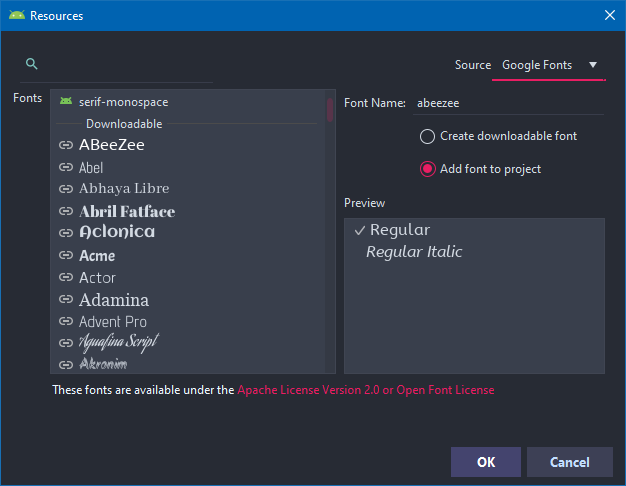
- Android studio typeface examples how to#
- Android studio typeface examples android#
- Android studio typeface examples code#
Also, consider how you might handle widgets whose typeface you don't want to change. I will leave handling the ActionBar as an exercise for the reader.

ĬonvertView = inflater.inflate(R.layout.listitem, null) įontChanger.replaceFonts((ViewGroup)convertView)
Android studio typeface examples android#
Therefore, you will also need to use the FontChangeCrawler in your adapters. Then we need to click on a particular view of the android studio XML file and select the more option of font-family attributes. The list items in a ListView are built within an adapter, not within an Activity. Replacing Activity fonts goes a long way, but most of us also have a plethora of ListViews. Super.onActivit圜reated(savedInstanceState) įontChanger.replaceFonts((ViewGroup) this.getView()) void onActivit圜reated(Bundle savedInstanceState) Consider placing this logic in a BaseFragment class. You will need to apply the FontChangeCrawler to each Fragment as well. If you are not familiar with android.R.id.content, it is the official ID given to the root View within an Activity's layout.Ĭonsider placing the above logic in a BaseActivity class. To replace the default font in every view within an Activity's layout, simply use the FontChangeCrawler from above, like so: void setContentView(View view)įontChangeCrawler fontChanger = new FontChangeCrawler(getAssets(), "font.otf") įontChanger.replaceFonts((ViewGroup)this.findViewById(android.R.id.content)) ((TextView) child).setTypeface(typeface) Public void replaceFonts(ViewGroup viewTree)įor(int i = 0 i < viewTree.getChildCount() ++i) 5) Provide the Activity Name and click finish. 4) Select the Activity type (Empty Activity). 3) Select the API level of application and click next. 2) Provide the following information: Application name, Company domain, Project location and Package name of application and click next. Typeface = Typeface.createFromAsset(assets, assetsFontFileName) 1) Select Start a new Android Studio project.

Public FontChangeCrawler(AssetManager assets, String assetsFontFileName) Public FontChangeCrawler(Typeface typeface) Here is a simple recursive implementation of a view crawler that will replace the Typeface for any appropriate view in the hierarchy: public class FontChangeCrawler When crawling this tree, one can replace all the Typefaces on any TextViews, EditTexts, and Buttons that are encountered.

This tree can be crawled by visiting child views in your favorite order (breadth first or depth first). Layouts (and sub-layouts) in Android are tree hierarchies comprised of ViewGroups as composite elements and Views as leaf nodes. This post covers a strategy that should handle your needs for common apps.
Android studio typeface examples how to#
Browse samples to learn how to build different components for your applications.
Android studio typeface examples code#
Instead you must employ a strategy to set a custom Typeface on all TextViews, EditTexts, and Buttons. A selection of code samples and templates for you to use to accelerate your app development. Android does not provide a mechanism for using a custom font file (TTF, OTF, etc) in all areas of your app.


 0 kommentar(er)
0 kommentar(er)
